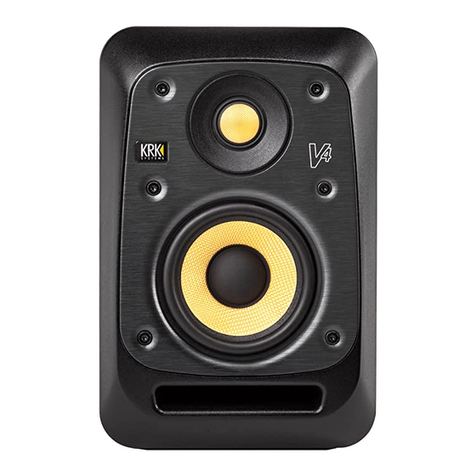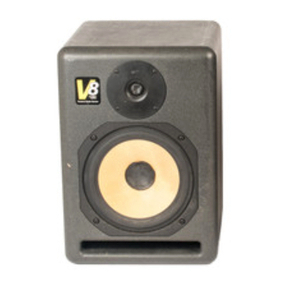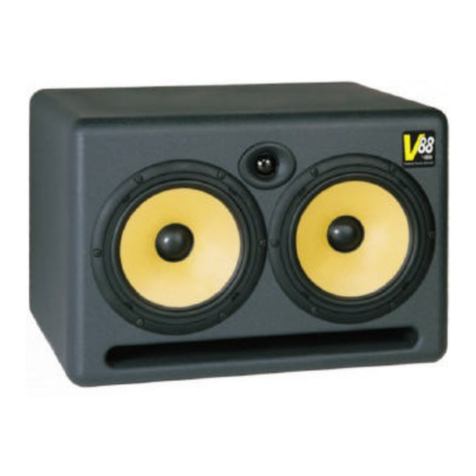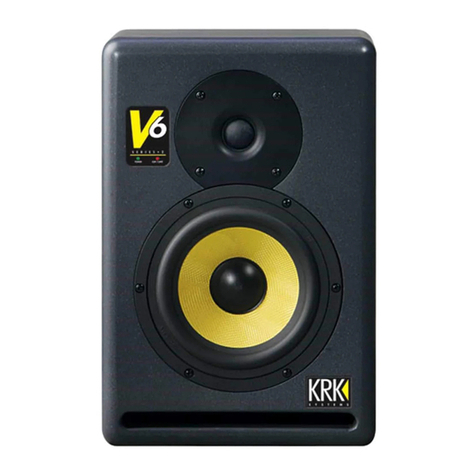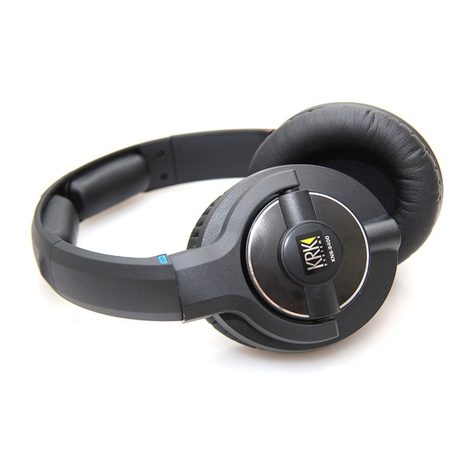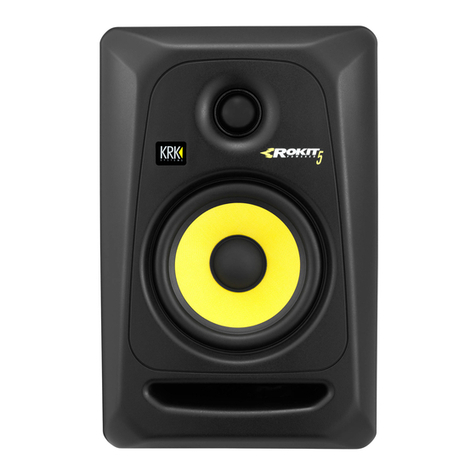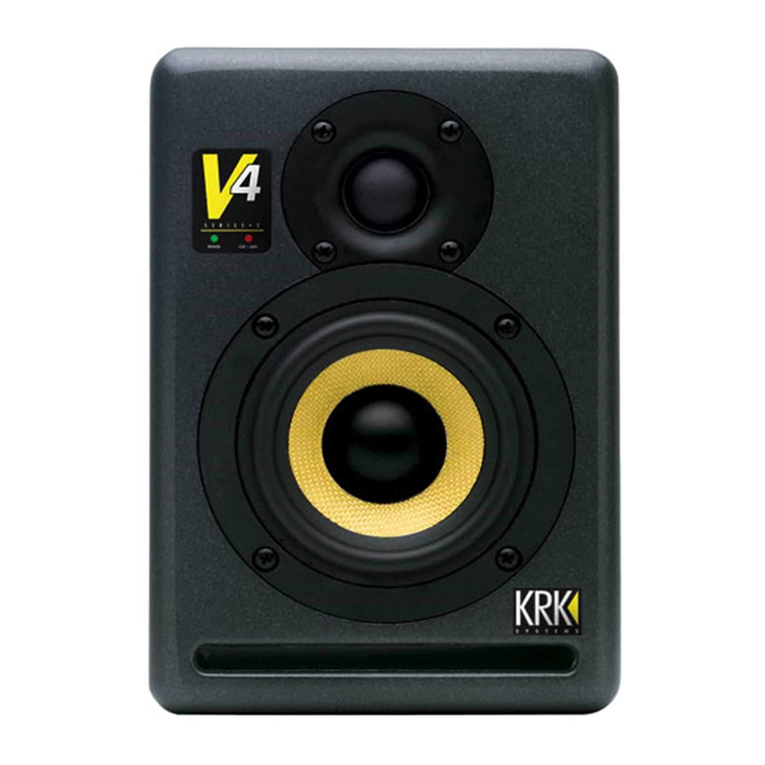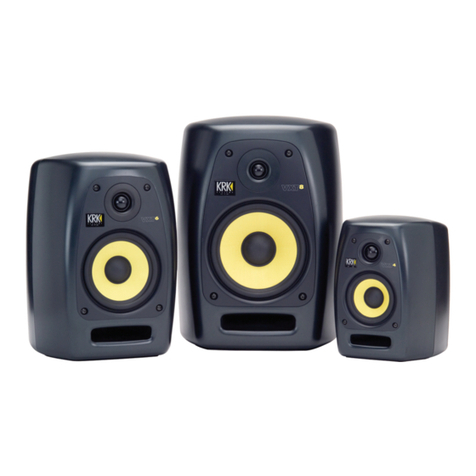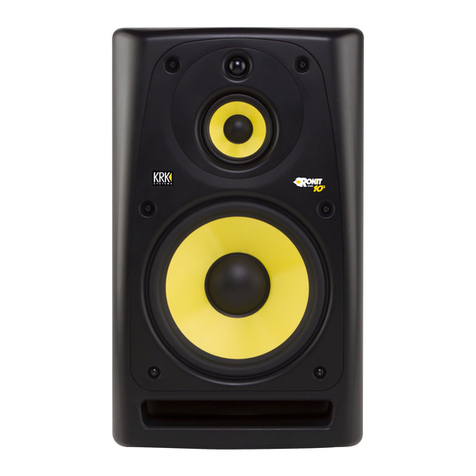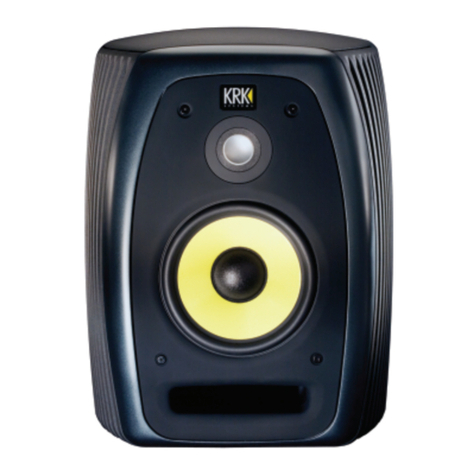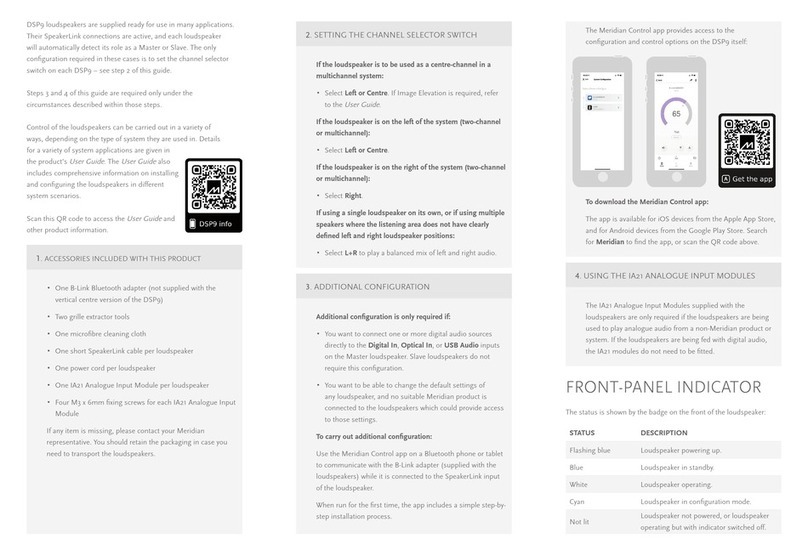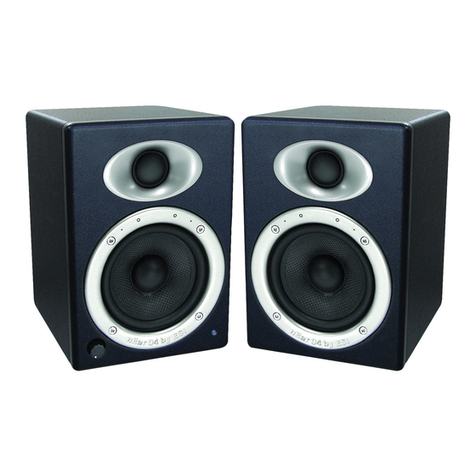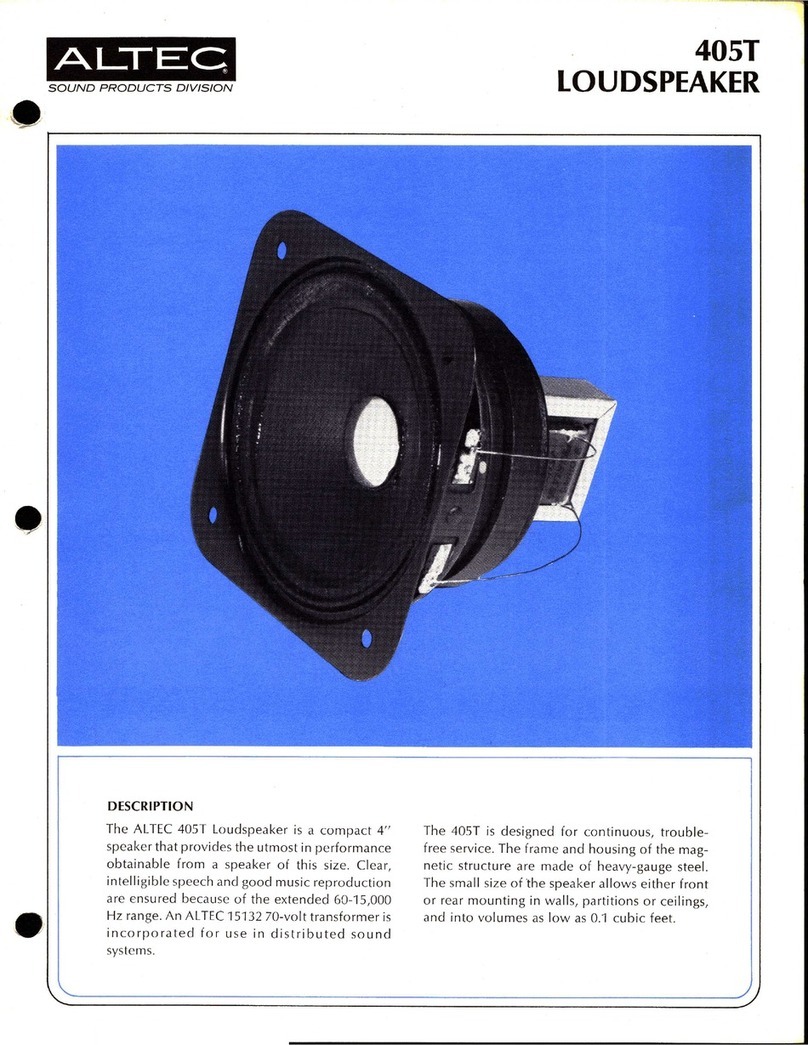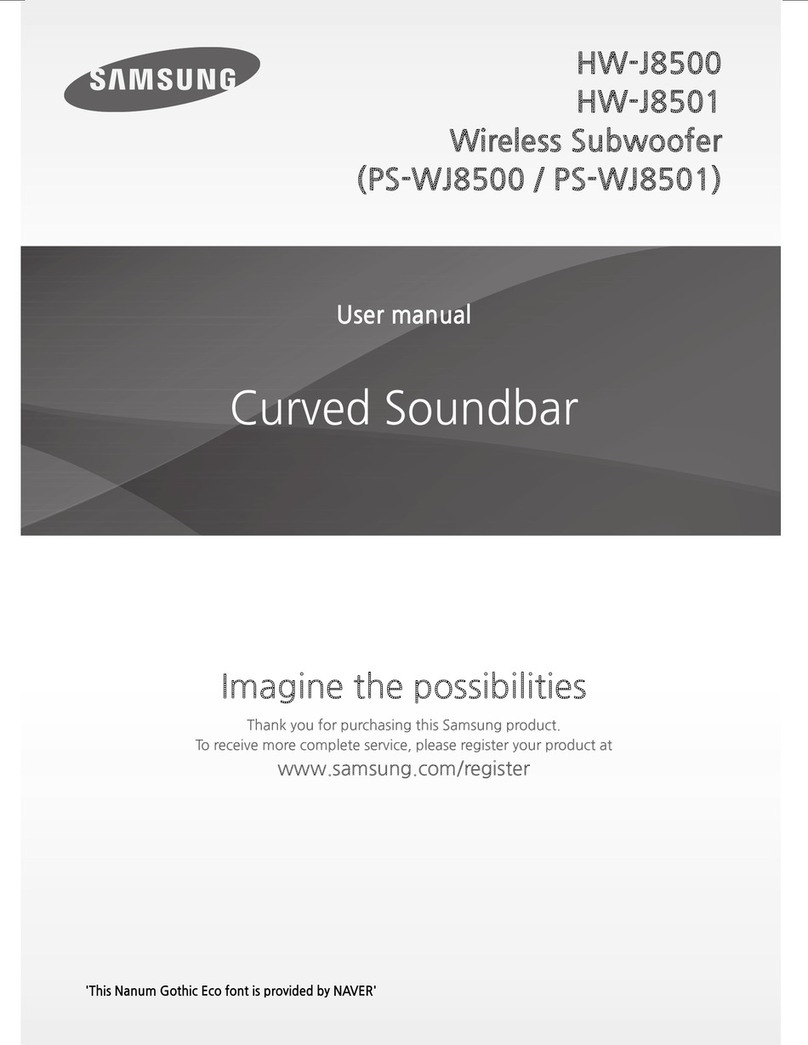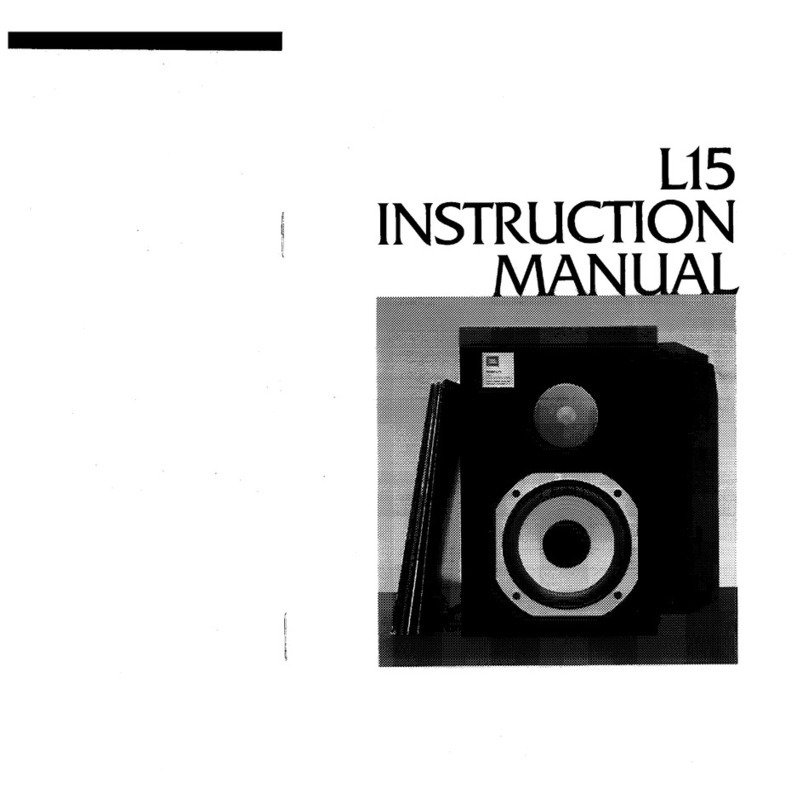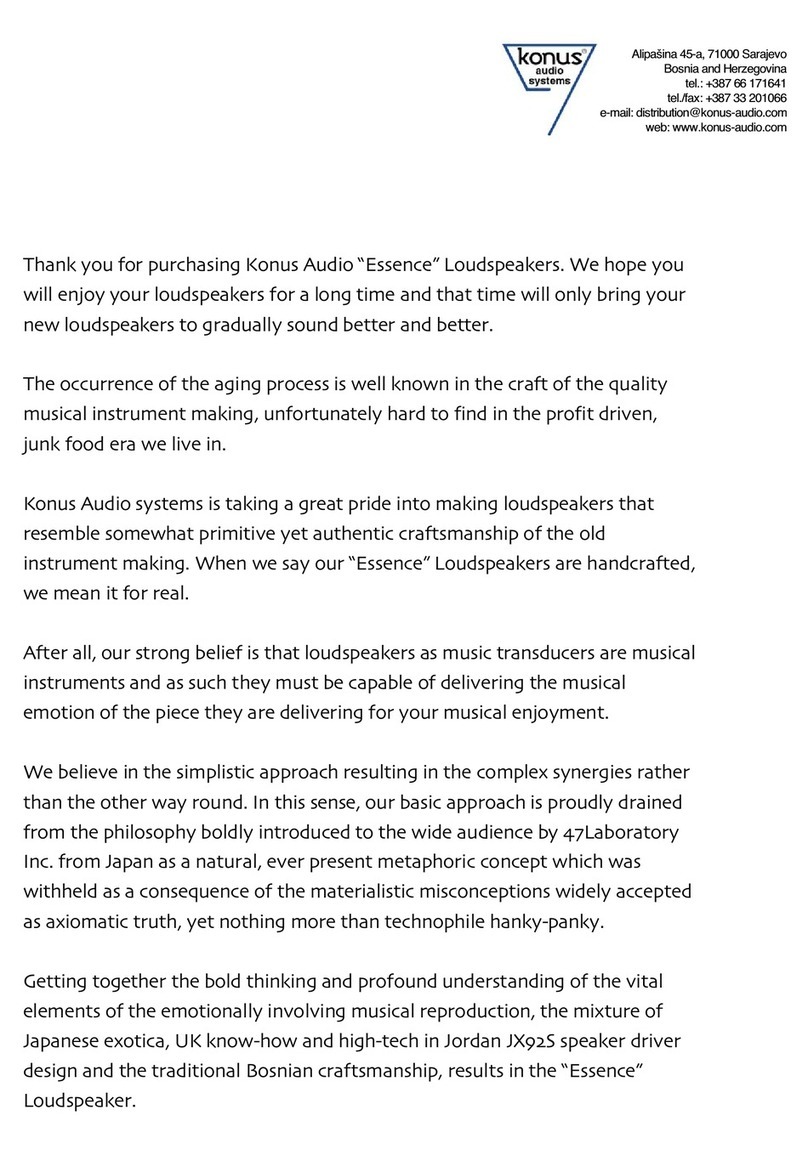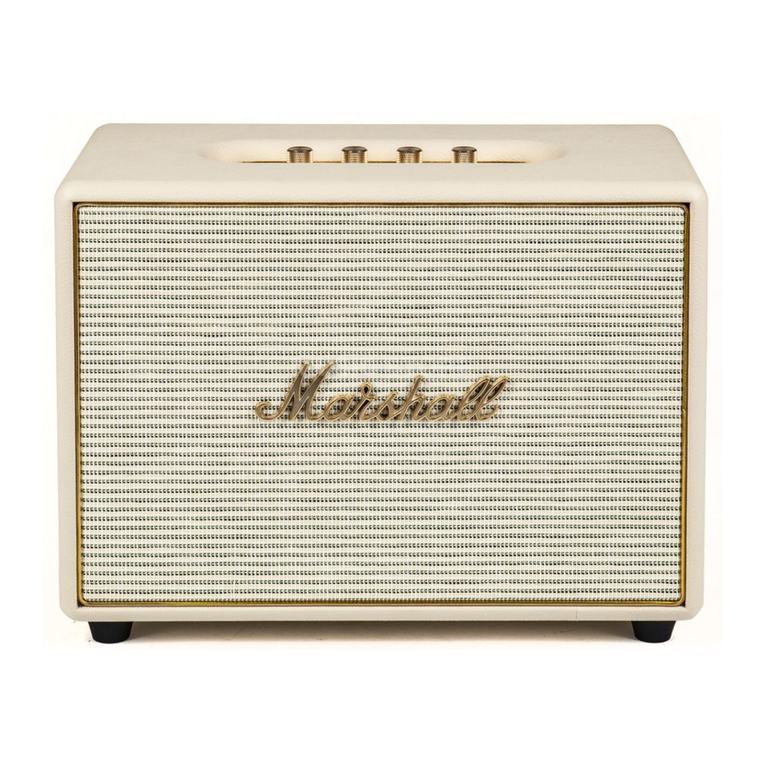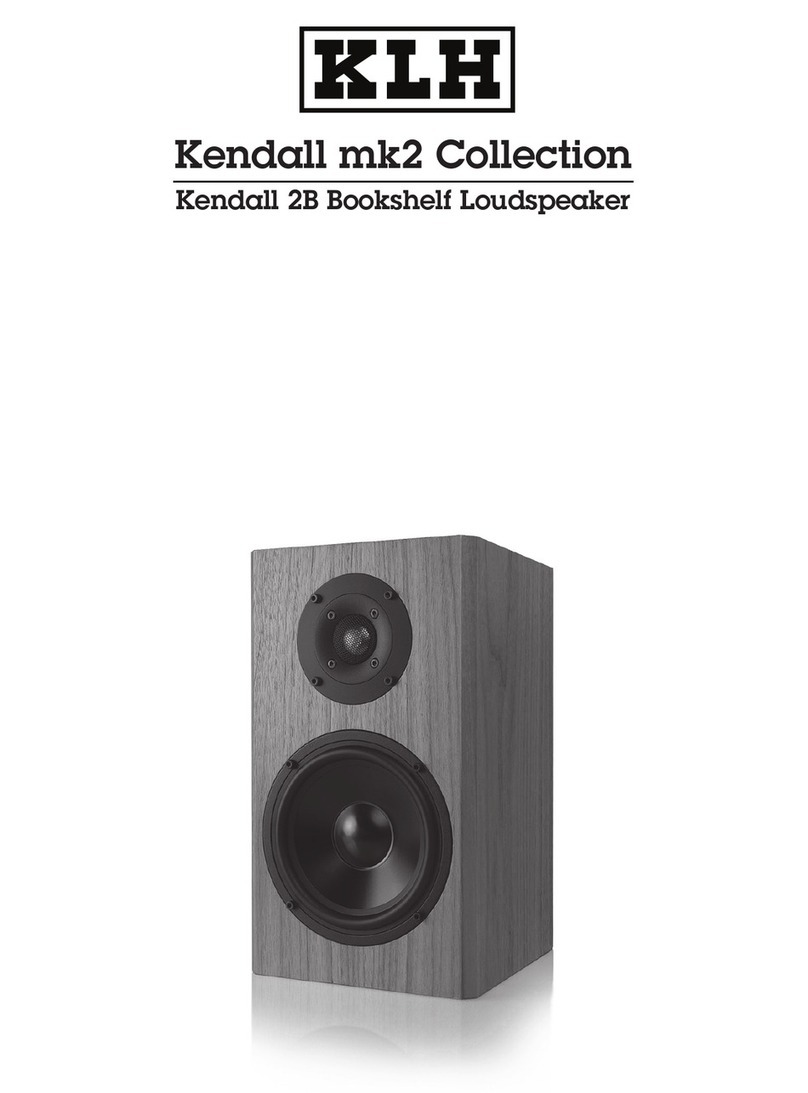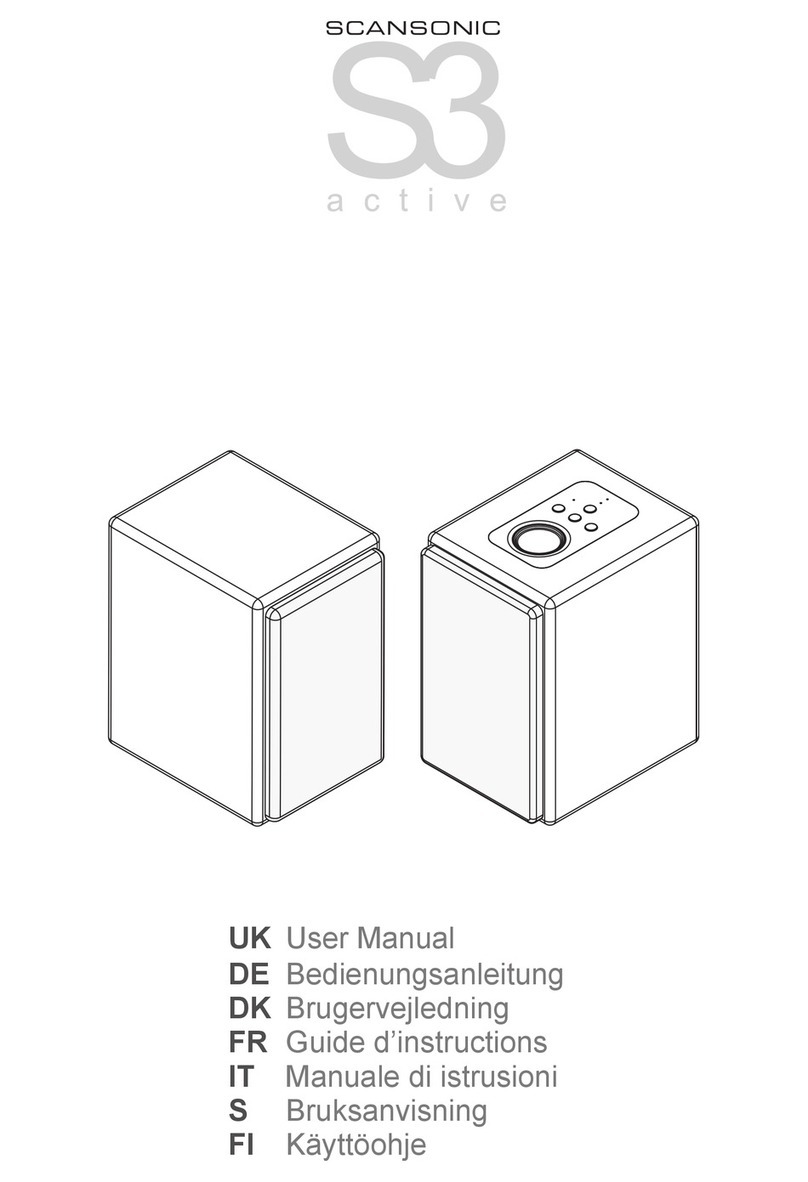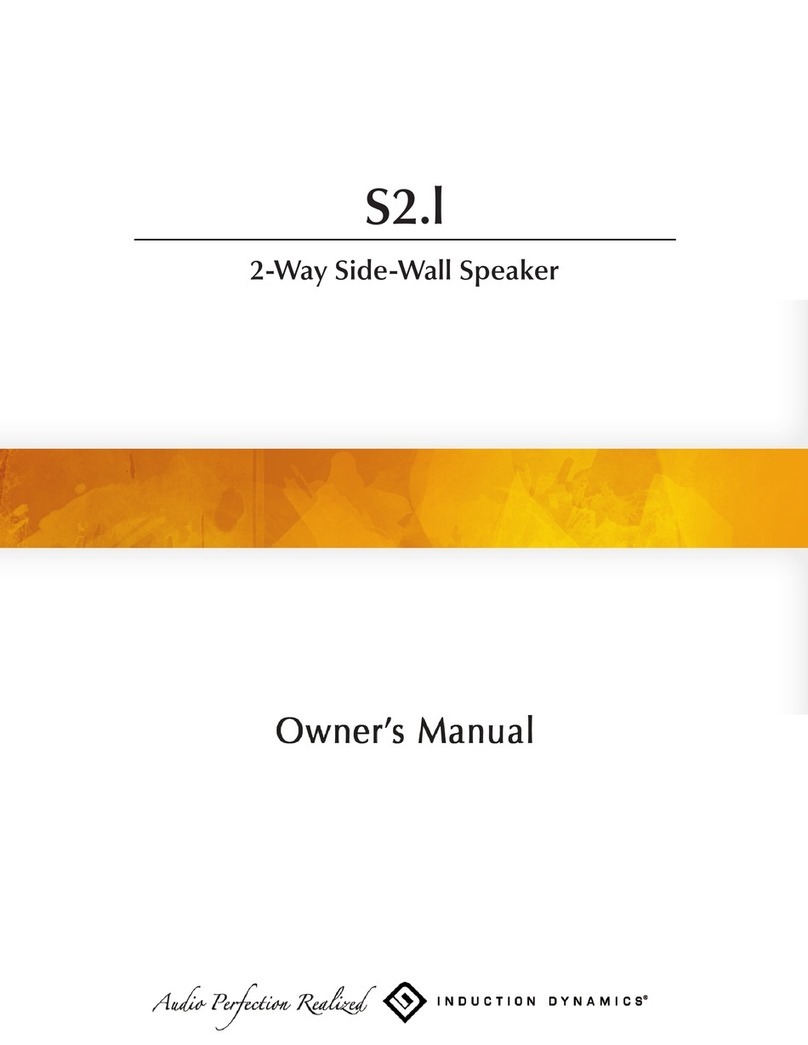KRK R6 User manual

R6
PASSIV STUDIO MONITORS
UUSSRR GGUUIIDD

ii
Warning: To reduce the risk of fire or electric shock, do not
expose this unit to rain or moisture.
The lightning flash with an arrowhead symbol within an equilateral
triangle, is intended to alert the user to the presence of uninsulated
dangerous voltage within the product’s enclosure that may be of
sufficient magnitude to constitute a risk of electric shock to persons.
The exclamation point within an equilateral triangle is intended to
alert the user to the presence of important operating and
maintenance (servicing) instructions in the literature accompanying
the product.
Do not place this unit on an unstable cart, stand or tripod, bracket
or table. The unit may fall, causing serious injury to a child or adult
and serious damage to the unit. Use only with a cart, stand, tripod,
bracket or table recommended by the manufacturer or sold with
the unit. Any mounting of the device on a wall or ceiling should
follow the manufacturer’s instructions and should use a mounting
accessory recommended by the manufacturer.
An appliance and cart combination should be moved with care.
Quick stops, excessive force and uneven surfaces may cause the
appliance and cart combination to overturn.
Read and follow all the safety and operating instructions before
connecting or using this unit. Retain this notice and the owners
manual for future reference.
All warnings on the unit and in its operating instructions should be
adhered to.
Do not use this unit near water; for example, near a bath tub,
washbowl, kitchen sink, laundry tub, in a wet basement or near a
swimming pool.
The unit should be installed so that its location or position does not
interfere with its proper ventilation. For example, it should not be
situated on a bed, sofa, rug or similar surface that may block the
ventilation openings; or placed in a built-in installation, such as a
bookcase or cabinet, that may impede the flow of air through its
ventilation openings.
The unit should be situated from heat sources such as radiators,
heat registers, stoves or other devices (including amplifiers) that
produce heat.
The unit should be connected to a power supply outlet only of the
voltage and frequency marked on its rear panel.
The power supply cord should be routed so that it is not likely to be
walked on or pinched, especially near the plug, convenience
receptacles, or where the cord exits from the unit.
Unplug the unit from the wall outlet before cleaning. Never use
benzine, thinner or other solvents for cleaning. Use only a soft
damp cloth.
The power supply cord of the unit should be unplugged from the
wall outlet when it is to be unused for a long period of time.
Care should be taken so that objects do not fall, and liquids are not
spilled into the enclosure through any openings.
This unit should be serviced by qualified service personnel when:
A. The power cord or the plug has been damaged; or
B. Objects have fallen, or liquid has been spilled into the unit; or
C. The unit has been exposed to rain or liquids of any kind; or
D. The unit does not appear to operate normally or exhibits a
marked change in performance; or
E. The device has been dropped or the enclosure damaged.
DO NOT ATTEMPT SERVICING OF THIS UNIT
YOURSELF. REFER SERVICING TO QUALIFIED
SERVICE PERSONNEL
Upon completion of any servicing or repairs, request the service
shops assurance that only Factory Authorized Replacement Parts
with the same characteristics as the original parts have been used,
and that the routine safety checks have been performed to
guarantee that the equipment is in safe operating condition.
REPLACEMENT WITH UNAUTHORIZED PARTS MAY RESULT IN
FIRE, ELECTRIC SHOCK OR OTHER HAZARDS.
ATTENTION
POUR …VITER LES CHOC ELECTRIQUES, INTRODUIRE LA
LAME LA PLUS LARGE DE LA FICHE DANS LA BORNE
CORRESPONDANTE DE LA PRISE ET POUSSER JUSQUíAU
FOND. CAUTION
TO PREVENT ELECTRIC SHOCK, MATCH WIDE BLADE OF
PLUG TO WIDE SLOT FULLY INSERT.
If an indoor antenna is used (either built into the set or installed
separately), never allow any part of the antenna to touch the metal
parts of other electrical appliances such as a lamp, TV set etc.
CAUTION
POWER LINES
Any outdoor antenna must be located away from all power lines.
OUTDOOR ANTENNA GROUNDING
If an outside antenna is connected to your tuner or tuner-
preamplifier, be sure the antenna system is grounded so as to
provide some protection against voltage surges and built-up static
charges. Article 810 of the National Electrical Code, ANSI/NFPA No.
70-1984, provides information with respect to proper grounding of
the mast and supporting structure, grounding of the lead-in wire to
an antenna discharge unit, size of grounding conductors, location
of antenna discharge unit, connection to grounding electrodes and
requirements for the grounding electrode.
a. Use No. 10 AWG (5.3mm2) copper, No. 8 AWG (8.4mm2)
aluminium, No. 17 AWG (1.0mm2) copper-clad steel or bronze
wire, or larger, as a ground wire.
b. Secure antenna lead-in and ground wires to house with stand-off
insulators spaced from 4-6 feet (1.22 - 1.83 m) apart.
c. Mount antenna discharge unit as close as possible to where lead-
in enters house.
d. Use jumper wire not smaller than No.6 AWG (13.3mm2) copper,
or the equivalent, when a separate antenna-grounding electrode
is used. see NEC Section 810-21 (j).
EXAMPLE OF ANTENNA GROUNDING AS PER NATIONAL
ELECTRICAL CODE INSTRUCTIONS CONTAINED IN
ARTICLE 810 - RADIO AND TELEVISION EQUIPMENT.
NOTE TO CATV SYSTEM INSTALLER: This reminder is
provided to call the CATV system installers attention to
Article 820-40 of the National Electrical Code that provides
guidelines for proper grounding and, in particular, specifies
that the ground cable ground shall be connected to the
grounding system of the building, as close to the point of
cable entry as practical.
CAUTION
RISKOFELECTRIC
SHOCK DO NOTOPEN
ATTENTION:
RISQUEDECHOCELECTRIQUE
NEPASOUVRIR
CAUTION: TO REDUCE THE RISK OF ELECTRIC
SHOCK, DO NOT REMOVE COVER (OR BACK). NO
USER SERVICEABLE PARTS INSIDE. REFER SERVICING
TO QUALIFIED SERVICE PERSONNEL.
IMPORTANT SAFETY INSTRUCTIONS
1. “An apparatus with Class I construction shall be connected to
a mains sockets outlet with protective earthing connection.”
2. “Where the mains plug or an appliance coupler is used as the
disconnect device, the disconnection device shall remain readily
operable.”
3. “1A fuse is used to US market, voltage will be set to 115V before
shipment: 500mA fuse is used to European market, voltage will
be set to 230V before shipment.”
SSaaffeettyy IInnssttrruuccttiioonnss

iii
CCoonntteennttss
CCoonntteennttss
SSaaffeettyy IInnssttrruuccttiioonnss........................................................................................................................................................ iiii
11..IInnttrroodduuccttiioonn.................................................................................................................................................................. 11
1.1. KRK Systems Design Philosophy .............................................. 1
22..TThhee BBaassiiccss...................................................................................................................................................................... 22
2.1. Unpacking and Visual Inspection ............................................ 2
2.2. Panels Overview .................................................................... 3
2.2.1. Front Panel .................................................................. 3
2.2.2. Back Panel ................................................................... 3
2.3. Amplifier Power Requirements ................................................. 4
2.4. Connecting your Monitors ...................................................... 5
33..PPoossiittiioonniinngg yyoouurr MMoonniittoorrss.......................................................................................................................... 66
3.1. Monitor-Room Interaction ....................................................... 6
3.2. Positioning your Monitors ....................................................... 6
3.2.1. Two - Channel Setup .................................................... 7
3.2.2. Subwoofer Setup .......................................................... 8
3.2.3. 5.1 Channel Surround Setup ......................................... 8
44..TTrroouubblleesshhoooottiinngg .................................................................................................................................................... 1100
55..SSppeecciiffiiccaattiioonnss .......................................................................................................................................................... 1122
-- SSPPAANNIISSHH version (page 13)
-- FFRRNNCCHH version (page 26)
-- GGRRMMAANN version (page 39)

1
11.. IInnttrroodduuccttiioonn
11..IInnttrroodduuccttiioonn
KRK Systems is the most dedicated monitor company in the world, and we are
thrilled you have joined our ever-growing family of loyal customers.
Congratulations!
The R6 is the ultimate passive solution in the new Generation 2 RoKit Studio
Monitor Series from KRK Systems. For years, the RoKit Series has been one of
the most popular choices for accurate monitoring, from project-studios to
top-notch music production and post-production venues. Now, the R6 provides
a new standard in passive monitoring with better performance and accuracy,
raising the bar once again. True, this is a lofty claim for this next generation KRK
series, considering KRK has always been the standard, but it is a fact.
To properly operate your new R6 monitors, we encourage you to invest a few
minutes and read this User Guide.
Thank you for choosing KRK and enjoy your R6s!
11..11KKRRKK SSyysstteemmss DDeessiiggnn PPhhiilloossoopphhyy
OOuurr FFooccuuss iiss YYoouurr MMiixx
At KRK, our focus has always been to make the most accurate studio monitors
available at any price.
We do not offer PA gear, mixers, or motorcycles – just the tools you need to
deliver a great mix. From the legendary xposé Series, to VXT, to the new RoKit
Generation 2 series – we really know recording monitors.
We do not add sonic characteristics like some other manufacturers that make
their monitors appear to provide more SPL, or add low frequencies that demo
well in the store. No smoke and mirrors here. Just 100% pure KRK!
When you use a KRK monitor, you can be confident that your mixes will
translate well to the wide variety of playback conditions that can occur in the real
world. We want your audio mixes to sound good everywhere – not just in your
studio!
So enough about why we do the things we do. Let’s read the basics…

2
22.. TThhee BBaassiiccss
22..11UUnnppaacckkiinngg aanndd VViissuuaall IInnssppeeccttiioonn
Before packing and shipping, your R6 monitors have been carefully inspected
and tested by the KRK team. However, after unpacking your monitors, please
carefully inspect them for exterior damage and immediately report any
physical damage during transit to your shipping carrier.
Please read the included Warranty Card and call KRK Customer Service at
(954) 316-1580 before sending your product to us. In some cases, our team
can resolve your problem immediately, avoiding down time due to shipping
delays. However, if Customer Service determines that a repair is needed; a
Return Material Authorization (RMA) number will be provided to you. After you
have obtained the RMA, you can return the R6s to the dealer where they were
purchased, or sent them directly to KRK Systems.
NNootteess
- For the fastest and safest product return to KRK Systems, please use
the original shipping boxes and packaging materials. KRK Systems
cannot be responsible for any damages incurred during the
shipping process due to poor or inadequate packing. Please
remember to insure your shipment!
- If your monitor is out of warranty and you would like to obtain a quote
before repairing your product, please include a note with your contact
information on it and we will contact you with a service quote. Service
will be performed once your method of payment has been
established and approved.

3
22.. TThhee BBaassiiccss
22..22PPaanneellss OOvveerrvviieeww
22..22..11FFrroonntt PPaanneell(Figure 1)
22..22..22BBaacckk PPaanneell (Figure 1.1)
Figure 1
Figure 1.1

This allows you to use a variety of different connections - ranging from bare
copper wire to lugs to banana plugs. Any of these types of cable ends will make
a good connection, but banana plugs will allow for quick disconnect whenever
necessary and eliminate the problem of stray strands of copper between the
terminals. On the amplifier side, use whatever type of end fits your power
amplifier; typically bare wire, ¼" TS plugs, lugs, or banana plugs.
NNootteeUse unshielded cables to connect your amplifier to your speakers.
If you are not sure if you have unshielded cables, contact your local
music dealer to purchase the proper cabling.
Input (Right/Left), (+/-). Standard 5-way binding posts for accepting signal from
your power amplifier. The posts will accept wire-gauge sizes as large as 14
gauges. KRK recommends using 14 gauges for the best sonic response.
22..33AAmmpplliiffiieerr PPoowweerr RReeqquuiirreemmeennttss
KRK recommends using power amplifiers capable of producing 50 -100 RMS
watts per channel into 8 ohms. For best sonic results, a good rule of thumb is
to use an amplifier capable of producing more than 1½ times the recommended
power, rather than one that produces less than the recommended power. In fact,
more speakers are damaged due to under-powering than to over-powering. An
amplifier with insufficient power will create square waves when pushed beyond
the "comfortable" running range (potentially damaging the voice-coils).
22.. TThhee BBaassiiccss
4
The R6 monitors use 5-way binding posts to connect to your amplifier.
(Figure 2)
Figure 2

Figure 2.1
5
22.. TThhee BBaassiiccss
22..44CCoonnnneeccttiinngg yyoouurr MMoonniittoorrss
When hooking up passive (non-powered) speakers such as the R6 studio
monitors, you have several choices as to the proper type of cable. First, only use
heavy 14 to 18-gauge unshielded cables. Sonically, the heavier 14-gauge cable
is the best choice. Next, keep the speaker cable runs as short as possible. Just
measure the proper length, leaving a few extra feet for later adjustments and
easy access. Whenever possible, remember to use a heavy-gauge, unshielded
cable, especially for long (over 20 ft) runs.
Also, avoid light-gauge "zip cord.” Light-gauge cables of considerable length
not only rob amplifier power directly by turning it into heat, but they also reduce
the damping factor of your power amplifier, (which can cause inaccuracies in
the bass response of the speakers). Long cable runs can also introduce frequency
response irregularities into the monitor system, especially around the crossover
points where complex impedances exist.
CCaauuttiioonnBefore to start with the following “hookup procedure,” please
turn
Off
the amplifier. Some amplifiers will self-destruct if their output
terminals are accidentally shorted together for even a few seconds.
If it is possible, use polarized speaker wire. This type of wire has one of the
conductors marked with a ridge, color stripe, or other identifier such as
copper- and white-colored conductors. This will allow you to easily hook up the
speakers with the proper polarity, (which is very important for proper stereo
imaging and bass response). Simply use the striped, ridged, red, or otherwise
polarity-marked lead of the cable to hook to the hot (red, + or positive)
terminal of the amplifier. Hook the other end of the cable to the red terminal on
the monitor cabinet. Repeat using the black (negative) terminal of the amplifier
being hooked to the black terminal of the speaker cabinet. Make sure there are
no stray strands of copper poking out that might short to the opposite terminal.
(Figure 2.1)
+
-

33..PPoossiittiioonniinngg yyoouurr MMoonniittoorrss
33..11MMoonniittoorr--RRoooomm IInntteerraaccttiioonn
The close-field monitor, by definition, reduces room interaction. This can be
compared to the conventional stereo configuration or the large monitor
arrangement in a recording studio where sounds emanating from the monitor
or reflecting off ceilings, walls, and floors greatly affect the sound quality. By
shortening the path to the ear, the close-field monitor offers a tremendous
amount of flexibility, allowing the sound to become less susceptible to differing
room conditions. The ability to adjust the high frequency characteristics is equally
important to help compensate for room irregularities and achieve the best sound
accuracy.
A room that is heavily dampened would typically require a slight high frequency
boost. Likewise, reducing the high frequencies can alter a reverberant room.
Placing the monitor close to a rear wall, sidewall, or a corner will reinforce the
low frequencies. If you move them two to three feet away from walls and
corners, you will hear less low frequency interaction (excluding any interaction
with the mixing console).
33..22PPoossiittiioonniinngg yyoouurr MMoonniittoorrss
Positioning your monitors correctly in the studio is critical to their performance.
Typically, they should be placed so that the listening position is fully
“covered” with all monitors resting on the same horizontal plane. To test a
monitor for its imaging capability, playback a song that includes acoustic
instruments, to fully represent the entire sound spectrum.
You can adjust the angle of each monitor by listening for dead spots. Keep in
mind, changing the angle or position of a monitor will change the way that you
perceive your music. So lets analyze the following monitors’ configurations;
33.. PPoossiittiioonniinngg yyoouurr MMoonniittoorrss
6

7
33.. PPoossiittiioonniinngg yyoouurr MMoonniittoorrss
33..22..11TTwwoo -- CChhaannnneell SSeettuupp
•
Near-Field Configuration
– In a control room situation, the monitors are often
times placed on the meter bridge or in a close-field listening position. Initial
placement starts by measuring out a simple equilateral triangle (all three sides
equal in length) with the apex at the center of the listening position as an
“overlay” for the stereo installation. In this configuration, the Left and Right
monitors are each placed at a 60° angle, equidistant from the listening position.
(Figure 3)
Figure 3
Figure 3.1
•
Mid-Field Configuration
– This configuration is similar to the close-field
configuration. It is normally used with larger monitors, or when the monitors
are too large or heavy for the meter bridge. This setup has the potential for a
larger sweet spot and better spatial imaging. Make sure that the height of the
woofer is above the height of the console. (Figure 3.1)

8
33.. PPoossiittiioonniinngg yyoouurr MMoonniittoorrss
33..22..22SSuubbwwooooffeerr SSeettuupp
Note that KRK subwoofers are optimized for use with KRK full range monitors.
Begin by determining the best location for your subwoofer. The optimum setup
is displayed in Figure 3.2. However, this setup may not be practical or possible
in your room. Once you have set up your monitors, listen to program material
that you know contains low frequency information. If your subwoofer has a
phase switch, adjust the subwoofer to provide the highest frequency setting
possible. Flip the switch back and forth to find the loudest setting. Then adjust
the sub’s low pass filter so that it works in conjunction with the satellite’s high
pass frequencies. When you have finished, readjust the level of the sub.
33..22..3355..11 CChhaannnneell SSuurrrroouunndd SSeettuupp
Begin by placing the Left and Right front channels 30 degrees from the Center
channel and equidistant to the listening position. The Left Surround (rear) and
Right Surround (rear) channels should be placed 110 degrees from the Center
channel. Their location should also be equidistant from the listening position. The
subwoofer (Low Frequency ffects) channel is most effective when situated
directly below the Center channel. If this is not possible, place the subwoofer just
to the right or left side and below the Center channel. nsure that the woofers
are above the height of the console. (Figure 3.3)
Figure 3.2

9
33.. PPoossiittiioonniinngg yyoouurr MMoonniittoorrss
Figure 3.3

10
44.. TTrroouubblleesshhoooottiinngg
44..TTrroouubblleesshhoooottiinngg
- For general issues, check out these tips...
•The power cord from your amplifier is plugged in.
• The connecting wires from your amplifier are connected to your speakers.
• All other powered components in your system are plugged in and
properly connected.
• Your main system gain control is turned up.
• Your signal source (for example, console, CD player, etc.) is
On
and
properly sending signal to your speakers.
- For specific problems, please read the following situations;
IIff yyoouu ccaannnnoott hheeaarr aannyy ssoouunndd......
Check the previous tips before continuing to the next steps. Then;
•Check to see if all other audio devices using the same AC outlet are still
operating.
Make sure that:
• The audio source cable is plugged into both the source output and the
amplifier input.
• The gain on the amplifier is turned up.
• The signal source (for example, mixing console, workstation, CD player, etc.)
is turned up to a level that can properly send a signal to the amplifier.

11
44.. TTrroouubblleesshhoooottiinngg
• If one of the monitors is working. xchange the cable (coming from the
amp) from the nonworking monitor to the working unit. This will
determine whether it is the monitor, a faulty cable, the amplifier, or some
other glitch in the audio chain.
• If the monitor is still not responding, please contact KRK Customer Service.
TThhee ssoouunndd qquuaalliittyy cchhaannggeess......
• Play some non-distorted source material at a low volume. Carefully cover
the tweeter (to block the sound) without touching the diaphragm. Is the woofer
producing a clean sound? If there is not a clear tonal quality or any sound
at all then the woofer probably needs to be replaced.
• Cover the woofer so you can hear mostly the tweeter. Is the tweeter
producing a clear sound? If there is not a clear tonal quality or any sound
at all then the tweeter probably needs to be replaced.
• Once you have a better idea of what may be at fault, please contact
KRK Customer Service.
TThhee mmoonniittoorr hhiisssseess,, hhuummss oorr mmaakkeess ootthheerr lloouudd nnooiisseess......
• Check the connections between the signal source and the amplifier and
then from the amp to the monitors.
• All audio equipment should use the same ground point. Check all other
devices using the same AC output in the building like dimmers, neon
signs, TV screens, and computer monitors. These devices should not be
using the same circuit.
To contact us, please visit the following page:
http://www.krksys.com/contact.php

12
55.. SSppeecciiffiiccaattiioonnss
55..SSppeecciiffiiccaattiioonnss
IImmppeeddaannccee8 ohms
SSeennssiittiivviittyy87 dB @ 1 m / 1 W
TTwweeeetteerrShielded, 1 inch soft dome
WWooooffeerr6” Aramid Glass Fiber
PPoowweerr HHaannddlliinngg ((RRMMSS))100 W
RReeccoommmmeennddeedd AAmmpplliiffiieerr PPoowweerr50 W -150 W (RMS) (8 ohms)
FFrreeqquueennccyy RReessppoonnssee49 Hz-20 kHz, ±2 dB
DDiissttoorrttiioonn<1% 1 W
CCrroossssoovveerr2.5 kHz, 2nd order
IInnppuutt CCoonnnneeccttiioonnss5-Way Gold Plated Binding Posts
DDiimmeennssiioonnss ((HH xx WW xx DD))13” x 10” x 10.9”
33.02 cm x 25.40 cm x 27.68 cm
WWeeiigghhtt19.62 lbs
8.89 kg

13
CCoonntteenniiddoo
11..IInnttrroodduucccciióónn.............................................................................................................................................................. 1144
1.1. Filosofía de diseño de KRK Systems ........................................ 14
22..LLooss eelleemmeennttooss bbáássiiccooss.................................................................................................................................... 1155
2.1. Desembalaje e inspección visual ............................................ 15
2.2. Resumen de los paneles ........................................................ 16
2.2.1.Panel frontal ................................................................ 16
2.2.2.Panel posterior ............................................................. 16
2.3. Requisitos del amplificador de potencia .................................. 17
2.4. Conexión de los monitores .................................................... 18
33..PPoossiicciioonnaammiieennttoo ddee llooss mmoonniittoorreess.................................................................................................... 1199
3.1. Interacción entre monitor y habitación .................................... 19
3.2. Posicionamiento de los monitores ........................................... 20
3.2.1. Configuración con dos canales .................................... 20
3.2.2. Configuración del subwoofer ....................................... 21
3.2.3. 5.1 Configuración de canales surround ........................ 22
44..PPrroobblleemmaass yy ssoolluucciioonneess ................................................................................................................................ 2233
55..ssppeecciiffiiccaacciioonneess.................................................................................................................................................... 2255
-- NNGGLLIISSHHversion (page iii)
-- FFRRNNCCHHversion (page 26)
-- GGRRMMAANNversion (page 39)
CCoonntteenniiddoo

14
11.. IInnttrroodduucccciióónn
11..IInnttrroodduucccciióónn
KRK Systems es la compañía de monitores más dedicada del mundo, y nos
encanta que se haya incorporado a nuestra siempre creciente familia de clientes
leales. ¡Felicitaciones!
l R6 es la máxima solución pasiva en la nueva Serie de Monitores de studio
Rokit Generation 2 de KRK Systems. Durante muchos años, la Serie RoKit ha
sido una de las opciones más populares para un monitoreo preciso, desde
estudios de proyectos hasta las instalaciones de producción y posproducción de
música de más alto nivel. Ahora, el R6 provee un nuevo estándar de monitoreo
pasivo que mejora el rendimiento y la precisión, aumentando una vez más el
nivel de referencia. s verdad, esta es una afirmación osada para esta serie
KRK de próxima generación, teniendo en cuenta que KRK siempre ha sido el
estándar, pero es un hecho.
Para operar correctamente sus nuevos monitores R6, le recomendamos invertir
unos pocos minutos y leer este Manual del Usuario.
¡Gracias por elegir a KRK y esperamos que disfrute de sus R6!
11..11FFiilloossooffííaa ddee ddiisseeññoo ddee KKRRKK SSyysstteemmss
NNooss ccoonncceennttrraammooss eenn ssuu mmeezzccllaa
n KRK, siempre nos hemos concentrado en fabricar los monitores de estudio
más precisos, independientemente del precio.
No ofrecemos equipos de altavoces públicos, mezcladoras ni motocicletas, sólo
las herramientas que usted necesita para obtener una excelente mezcla. Desde
la legendaria Serie xposé, pasando por VXT, hasta la nueva serie RoKit
Generation 2, realmente sabemos de monitores de grabación.
No agregamos características sónicas como otros fabricantes que
aparentemente hacen que sus monitores parezcan brindar más SPL, o agregan
bajas frecuencias que suenan bien en la tienda. Aquí no hay ningún truco.
¡Solamente oro puro de KRK! Cuando usted usa un monitor KRK, puede tener
la confianza de que sus mezclas se trasladarán bien a la amplia gama de
situaciones de reproducción que pueden ocurrir en el mundo real.

15
22.. LLooss eelleemmeennttooss bbáássiiccooss
¡Queremos que sus mezclas de audio suenen bien en todas partes, no
solamente en su estudio! Pero ya basta de hablar de por qué hacemos lo que
hacemos. Leamos lo básico...
22..LLooss eelleemmeennttooss bbáássiiccooss
22..11DDeesseemmbbaallaajjee ee iinnssppeecccciióónn vviissuuaall
Antes de empacar y enviar sus monitores R6, los mismos han sido
inspeccionados y probados cuidadosamente por el equipo de KRK.
Sin embargo, después de desempacar los monitores, inspecciónelos
cuidadosamente para ver si hay daños exteriores, e informe inmediatamente al
transportador de cualquier daño físico sufrido por la mercancía en tránsito.
Por favor lea la Tarjeta de Garantía adjunta y llame al Servicio al Cliente de KRK
al (954) 316-1580 antes de enviarnos su producto. n algunos casos, nuestro
equipo puede resolver su problema de inmediato, evitando así la pérdida de
uso del equipo debido a las demoras del envío. Sin embargo, si el Servicio al
Cliente determina que se requiere una reparación, se le dará a usted un número
de Autorización de Devolución de Material (RMA). Una vez que haya obtenido
la RMA, puede devolver los R6 al concesionario donde los compró, o enviarlos
directamente a KRK Systems.
NNoottaass
- Para obtener la devolución más rápida y segura a KRK Systems,
utilice las cajas y materiales de embalaje originales. KRK Systems no
se puede hacer responsable de los daños ocurridos durante el
proceso de envío a causa de un embalaje inadecuado. ¡Y no se
olvide de asegurar su envío!
-Si la garantía de su monitor se ha vencido y quiere obtener
una estimación de precio antes de reparar su producto, incluya
una nota con sus datos de contacto y nos comunicaremos con
usted para darle un precio de servicio. Una vez que su método
de pago haya sido establecido y aprobado, se llevará a cabo
el servicio.

16
22.. LLooss eelleemmeennttooss bbáássiiccooss
22..22RReessuummeenn ddee llooss ppaanneelleess
22..22..11PPaanneell ffrroonnttaall (Figura 1)
22..22..22PPaanneell ppoosstteerriioorr (Figura 1.1)
Figura 1
Figura 1.1

17
22.. LLooss eelleemmeennttooss bbáássiiccooss
Los monitores R6 usan conectores múltiples de 5 vías para la conexión a su
amplificador (Figura 2).
sto le permite usar distintas conexiones, desde alambre de cobre desnudo
hasta lengüetas (lug) o enchufes tipo banana. Cualquiera de estas terminaciones
de cables ofrecerá una buena conexión, pero los enchufes tipo banana
permiten desconectar rápidamente cuando sea necesario y eliminar el
problema de las hebras de cobre deshilachadas entre los terminales. Del lado
del amplificador, use el tipo de terminación que se adapte a su amplificador de
potencia, típicamente alambre desnudo, enchufes TS de ¼", lengüetas o
enchufes tipo banana.
NNoottaaUse cables sin camisa para conectar el amplificador a sus altavoces.
Si no está seguro de tener cables sin camisa, consulte a su tienda local de
música para comprar los cables adecuados.
ntrada (Derecha/Izquierda), +/-. Conectores múltiples estándar de 5 vías
para aceptar la señal del amplificador de potencia. Los postes aceptan calibres
de alambre de hasta 14. KRK recomienda usar alambres de calibre 14 para
obtener la mejor respuesta sónica.
22..33RReeqquuiissiittooss ddeell aammpplliiffiiccaaddoorr ddee ppootteenncciiaa
KRK recomienda usar amplificadores de potencia capaces de generar 50 a
100 vatios (RMS) por canal en 8 ohmios. Para obtener los mejores resultados
sónicos, una buena regla práctica es usar un amplificador capaz de generar
más de 1 vez y media la potencia recomendada, en lugar de usar uno que
genere menos de la potencia recomendada. De hecho, los altavoces se dañan
más a menudo debido a la potencia demasiado baja que a la demasiado alta.
Figura 2
Table of contents
Languages:
Other KRK Speakers manuals
